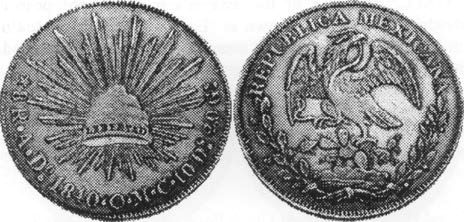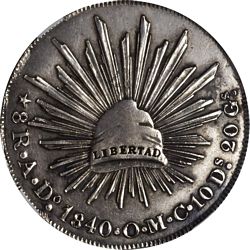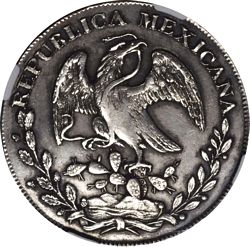The Durango Mint Pattern 8 Reales of 1840
by Kent Ponterio

Durango Mint 1840-OMC Pattern 8 Reales
Nickel plated copper, grained edge reeding.
Specific gravity of 8.83. KM-Pn57; BH-Pn48.
The Republic of Mexico produced "cap & ray" 8 Reales at fourteen different mints from 1823-1897. The mint located in Mexico City served as the primary mint for the central government. A regulation was in place that the remaining thirteen mints were required to obtain specific minting equipment such as dies and matrices directly from the Mexico City mint. For this reason, stylistically the coins struck by the various mints were intended to be virtually identical with the exception of mint marks and assayer's letters, however this was not always the case and at times they tended to vary greatly.
For numerous reasons several of the branch mints acquired dies and or hubs from sources other than the Mexico City mint. European firms such as the Soho mint in Birmingham England, among others were able to supply the Mexican branch mints with desperately needed items such as coining dies at a significantly cheaper cost and often with a quicker turn around rate than that of the Mexico City mint. Although the origin of manufacture for certain die styles is known, for several it is not. Dies manufactured from sources other than the Mexico City mint were considered contraband and therefore illegal. For this reason, it is unlikely any of the Mexican branch mints kept actual mint records that point to the origin of their manufacture.
The Durango Mint Pattern 8 Reales of 1840 has been subject to several theories as to where it may have originated. Examining the characteristics of this coin can however help point us in a better direction.
1. The coin has a specific gravity of 8.83 which makes it nickel plated copper rather than base metal silver or German silver as previously thought. Normally found with varying degrees of flat strike most likely due to the amount of pressure needed when striking hard metals such as nickel.
2. The coin is struck with a steam press rather than with a screw press and bears reeded edge rather than a milled edge. The letters "O.M.C." in place of the assayer's initials could possibly represent "Oeschger Mesdach & Co." also known as "Eschger, Ghesquiere & Co." This firm had offices in France, as well as other countries in Europe and produced coins for various countries. ForrerForrer, Biographical Dictionary of Medallists cites "Flans et pieces de monnaies de nickel, de cuirvre et de bronze fabriques par MM. Oeschger, Mecdach et Cie" in his "Biographical Dictionary of Medallists." The metal, style and method of which this pattern was produced along with the placement of "O.M.C." in the legend would suggest that this is the firm responsible for its manufacture.
Another pattern was of silver plated nickel. The following example was "struck without eagle's breast in full relief which is a common sight on the other examples either silvered bronze or silvered nickel patterns of this type. Edge is also incomplete with about a third of it not having reeding".


KM-Pn59. Silver-Plated Nickel 8 Reales Pattern, 1840-Do OMC (Stack's-Bowers Auction, 13 February 2019, lot 71086)
